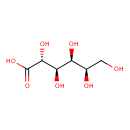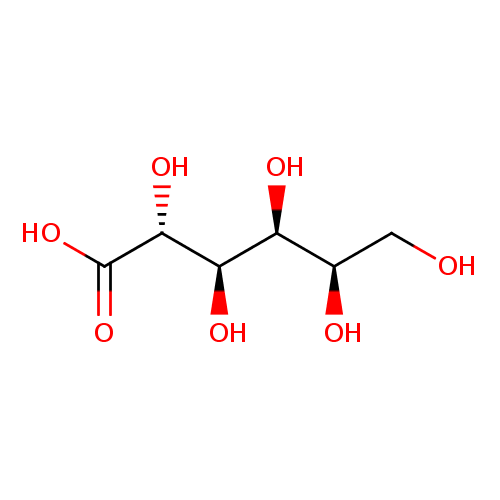|
Record Information |
|---|
| Version |
1.0 |
|---|
| Update Date |
1/22/2018 11:54:54 AM |
|---|
|
Metabolite ID | PAMDB120414 |
|---|
|
Identification |
|---|
| Name: |
L-gulonate |
|---|
| Description: | The L-enantiomer of gulonate. |
|---|
|
Structure |
|
|---|
| Synonyms: | - Gulonate
- L-Gulonate
- L-gulonate
|
|---|
|
Chemical Formula: |
C6H11O7 |
|---|
| Average Molecular Weight: |
195.149 |
|---|
| Monoisotopic Molecular
Weight: |
196.0583 |
|---|
| InChI Key: |
RGHNJXZEOKUKBD-QTBDOELSSA-M |
|---|
| InChI: | InChI=1S/C6H12O7/c7-1-2(8)3(9)4(10)5(11)6(12)13/h2-5,7-11H,1H2,(H,12,13)/p-1/t2-,3+,4-,5-/m0/s1 |
|---|
| CAS
number: |
20246-53-1 |
|---|
| IUPAC Name: | L-gulonate |
|---|
|
Traditional IUPAC Name: |
gulonic acid |
|---|
| SMILES: | C(O)C(O)C(O)C(O)C(O)C(=O)[O-] |
|---|
|
Chemical Taxonomy |
|---|
|
Taxonomy Description | This compound belongs to the class of chemical entities known as medium-chain hydroxy acids and derivatives. These are hydroxy acids with a 6 to 12 carbon atoms long side chain. |
|---|
|
Kingdom |
Chemical entities |
|---|
| Super Class | Organic compounds |
|---|
|
Class |
Organic acids and derivatives |
|---|
| Sub Class | Hydroxy acids and derivatives |
|---|
|
Direct Parent |
Medium-chain hydroxy acids and derivatives |
|---|
| Alternative Parents |
|
|---|
| Substituents |
- Medium-chain hydroxy acid
- Medium-chain fatty acid
- Beta-hydroxy acid
- Hydroxy fatty acid
- Alpha-hydroxy acid
- Monosaccharide
- Fatty acyl
- Fatty acid
- Secondary alcohol
- Polyol
- Monocarboxylic acid or derivatives
- Carboxylic acid
- Carboxylic acid derivative
- Organooxygen compound
- Hydrocarbon derivative
- Organic oxide
- Carbonyl group
- Primary alcohol
- Alcohol
- Organic oxygen compound
- Aliphatic acyclic compound
|
|---|
| Molecular Framework |
Aliphatic acyclic compounds |
|---|
| External Descriptors |
Not Available |
|---|
|
Physical Properties |
|---|
| State: |
Solid |
|---|
| Charge: | -1 |
|---|
|
Melting point: |
Not Available |
|---|
| Experimental Properties: |
| Property | Value | Reference |
|---|
| Melting Point | Not Available | Not Available | | Boiling Point | Not Available | Not Available | | Water Solubility | Not Available | Not Available | | LogP | Not Available | Not Available |
|
|---|
| Predicted Properties |
|
|---|
|
Biological Properties |
|---|
| Cellular Locations: |
Not Available |
|---|
| Reactions: | |
|---|
|
Pathways: |
|
|---|
|
Spectra |
|---|
| Spectra: |
|
|---|
|
References |
|---|
| References: |
- ASHWELL G, KANFER J, SMILEY JD, BURNS JJ: Metabolism of ascorbic acid and related uronic acids, aldonic acids, and pentoses. Ann N Y Acad Sci. 1961 Apr 21;92:105-14. [13684759 ]
|
|---|
| Synthesis Reference: |
Not Available |
|---|
| Material Safety Data Sheet (MSDS) |
Download (PDF) |
|---|
|
Links |
|---|
| External Links: |
|
|---|


